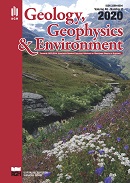An evaluation of the impact of shot and receiver lines spacing on seismic data quality – the Wierzbica 3D AGH seismic experiment
DOI:
https://doi.org/10.7494/geol.2020.46.2.93Keywords:
seismic data interpretation, signal-to-noise ratio, seismic attributesAbstract
An attempt was made to describe the quality of the stacked seismic data semi-quantitatively with respect to the spacing of shot and receiver lines. The methods used included: signal-to-noise ratio calculation, seismic-to-well tie accuracy, wavelet extraction effectiveness and reliability of semi-automated interpretation of seismic attributes. This study was focused on the Ordovician-Silurian interval of the Lublin Basin, Poland, as it was considered as a main target for the exploration of unconventional hydrocarbon deposits. Our results reconfirm the obvious dependency between the density of the acquisition parameters and data quality. However, we also discovered that the seismic data quality is less affected by the shot line spacing than by comparable receiver line spacing. We attributed this issue to the fact of the higher irregularity of the shot points than receiver points, imposed by the terrain accessibility. We have also proven that the regularity of receiver and shot point distribution is crucial for the reliable interpretation of structural seismic attributes, since these were found to be highly sensitive to the acquisition geometry.
Downloads
References
Barmuta J., Hadro P. & Dzwinel K., 2017. Determination of fracture distribution based on seismic attributes and geomechanical modelling. Acta Mineralogica-Petrographica, 32, 614, 4–5.
Chaouch A. & Mari J.L., 2006. 3-D Land Seismic Surveys: Definition of Geophysical Parameter. Oil & Gas Science and Technology – Revue d’IFP Energies nouvelles, 61, 611– 630.
Cordsen A., Galbraith M. & Peirce J., 2000. Planning Land 3-D Seismic Surveys. Society of Exploration Geophysicists. https://doi.org/10.1190/1.9781560801801.
Fusen X., Jinli Y., Bo L., Meng Z., Rong L., Fang L., Hongping X., Xue L., Qinglin L. & Heesom T., 2014. High-density 3D point receiver seismic acquisition and processing; a case study from the Sichuan Basin, China. First Break, 32, 1, 81–90.
Golonka J., 2009. Phanerozoic paleoenvironment and paleolithofacies maps: Early Paleozoic. Geologia – Kwartalnik Akademii Górniczo-Hutniczej im. Stanisława Staszica w Krakowie, 35, 4, 589–654.
Hakenberg M. & Świdrowska J., 2001. Cretaceous basin evolution in the Lublin area along the Teisseyre-Tornquist Zone (SE Poland). Annales Societatis Geologorum Poloniae, 71, 1, 1–20.
Kotański Z. & Buła Z., 1997. Atlas geologiczny Polski: mapy geologiczne ścięcia poziomego: 1:750 000. Wydawnictwa Kartograficzne Polskiej Agencji Ekologicznej, Warszawa.
Krzywiec P., 2009. Devonian–Cretaceous repeated subsidence and uplift along the Teisseyre–Tornquist zone in SE Poland – Insight from seismic data interpretation. Tectonophysics, 475, 1, 142–159.
Krzywiec P., Mazur S., Gągała Ł., Kufrasa M., Lewandowski M., Malinowski M. & Buffenmyer V., 2017. Late Carboniferous thin-skinned compressional deformation above the SW edge of the East European craton as revealed by seismic reflection and potential field data: Correlations with the Variscides and the Appalachians. [in:] Law R.D., Thigpen J.R., Merschat A.J. & Stowell H.H. (eds.), Linkages and Feedbacks in Orogenic Systems, GSA Memoir, 213, Geological Society of America, Boulder, 353–372.
Kufrasa M., Słonka Ł., Krzywiec P., Dzwinel K. & Zacharski J., 2018. Fracture pattern of the Lower Paleozoic sedimentary cover in the Lublin Basin of southeastern Poland derived from seismic attribute analysis and structural restoration. Interpretation, 6, 3, SH73–SH89.
Meunier J. & Bianchi T., 2005. Cost effective, high density vibroseis acquisition. SEG Technical Program Expanded Abstracts 2005 , 44–47. https://doi.org/10.1190/1.2142239.
Meunier J., Bianchi T., Postel J. & Taylor R., 2008. The future of vibroseis for high-density wide-azimuth land acquisition. First Break, 26, 2, 87–91.
Narkiewicz M., 2010. Development and inversion of Devonian and Carboniferous basins in the eastern part of the Variscan foreland (Poland). Geological Quaterly, 51, 231–256.
Ourabah A., Keggin J., Brooks C., Ellis D. & Etgen J., 2015. Seismic acquisition, what really matters? SEG Technical Program Expanded Abstracts 2015, 6–11. https://doi. org/10.1190/segam2015-5844787.1.
Pedersen S.I., Randen T., Sonneland L. & Steen Ø., 2002. Automatic fault extraction using artificial ants. SEG Technical Program Expanded Abstracts 2002, 512–515. https://doi.org/10.1190/1.1817297.
Poprawa P., 2006. Neoproterozoiczny rozpad superkontynentu Rodinii/Pannotii – Zapis w rozwoju basenów osadowych na zachodnim skłonie Baltiki. Prace – Państwowy Instytut Geologiczny , 186, 165 –188.
Porębski S.J., Prugar W. & Zacharski J., 2013. Silurian shales of the East European Platform in Poland – some exploration problems. Przegląd Geologiczny, 61, 11/1, 630–638.
Seeni S.R., Robinson S., Denis M., Sauzedde P. & Taylor R., 2010. Future-proof seismic: high-density full-azimuth. First Break, 28, 6, 79–88. https://doi.org/0.3997/1365-2397.28.6.40607.
Tomaszczyk M. & Jarosiński M., 2017. The Kock Fault Zone as an indicator of tectonic stress regime changes at the margin of the East European Craton (Poland). Geological Quarterly, 61, 908–925.
Waksmundzka M.I., 2010. Sequence stratigraphy of Carboniferous paralic deposits in the Lublin Basin (SE Poland). Acta Geologica Polonica, 60, 4, 557–597.
Wang X., 2015. Full-Azimuth, High-Density, 3D Single -Point Seismic Survey for Shale Gas Exploration in a Loess Plateau Area, Southeast of Ordos Basin, China. Energy Exploration & Exploitation, 33, 339–361. https:// doi.org/10.1260/0144-5987.33.3.339.
White R.E., 1973. The estimation of signal spectra and related quantities by means of the multiple coherence function. Geophysical Prospecting, 21, 4, 660–703.
Xiao F., Yang J., Liang B., Zhang M., Li R., Li F., Xiao H., Lei X. & Liu Q., 2014. Full azimuth high density point source and receiver acquisition helps better characterize geological details in a tight sand reservoir and carbonate reservoir in Sichuan Basin. [in:] Beijing 2014 International Geophysical Conference & Exposition, Beijing, China, 21–24 April 2014, Society of Exploration Geophysicists and Chinese Petroleum Society, 195–199. https://doi. org/10.1190/IGCBeijing2014-051.
Downloads
Published
Issue
Section
License
Authors have full copyright and property rights to their work. Their copyrights to store the work, duplicate it in printing (as well as in the form of a digital CD recording), to make it available in the digital form, on the Internet and putting into circulation multiplied copies of the work worldwide are unlimited.
The content of the journal is freely available according to the Creative Commons License Attribution 4.0 International (CC BY 4.0)










